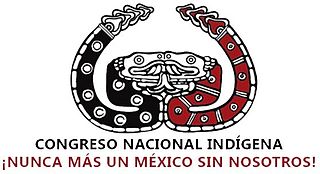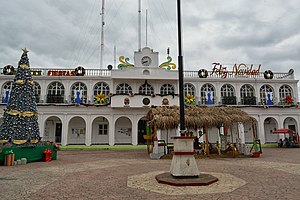
Chiapas, officially the Free and Sovereign State of Chiapas, is one of the states that make up the 32 federal entities of Mexico. It comprises 124 municipalities as of September 2017 and its capital and largest city is Tuxtla Gutiérrez. Other important population centers in Chiapas include Ocosingo, Tapachula, San Cristóbal de las Casas, Comitán, and Arriaga. Chiapas is the southernmost state in Mexico, and it borders the states of Oaxaca to the west, Veracruz to the northwest, and Tabasco to the north, and the Petén, Quiché, Huehuetenango, and San Marcos departments of Guatemala to the east and southeast. Chiapas has a significant coastline on the Pacific Ocean to the southwest.

The Zapatista Army of National Liberation, often referred to as the Zapatistas, is a far-left political and militant group that controls a substantial amount of territory in Chiapas, the southernmost state of Mexico.

Chiapas is a state in Southwest Mexico. According to the 2020 Mexican Census, it has the eighth largest population of all states with 5,543,828 inhabitants and the 10th largest by land area spanning 73,560.47 square kilometres (28,401.86 sq mi). Chiapas is officially divided into 124 municipalities, although the establishment of municipal authorities in Belisario Domínguez was suspended in 2015 pending the resolution of a territorial dispute between Chiapas and the neighbouring state of Oaxaca. In 2021, the Mexican Supreme Court resolved this dispute in Oaxaca's favour, and annulled the 2011 decree that had created Belisario Domínguez.

Juchitán de Zaragoza is an indigenous town in the southeast of the Mexican state of Oaxaca. It is part of the Juchitán District in the west of the Istmo de Tehuantepec region. With a 2020 census population of 88,280, it is the third-largest city in the state. The majority of the indigenous inhabitants are Zapotecs and Huaves. The town also serves as the municipal seat for the surrounding municipality, with which it shares a name. The municipality has an area of 414.64 km2 and a population of 113,570, the state's third-largest in population.

Samuel Ruiz García was a Mexican Catholic prelate who served as bishop of the Diocese of San Cristóbal de las Casas, Chiapas, from 1959 until 1999. Ruiz is best known for his role as mediator during the conflict between the Zapatista Army of National Liberation (EZLN) and the Institutional Revolutionary Party (PRI), a Mexican political party which had held power for over seventy years, and whose policies were often disadvantageous to the indigenous populations of Chiapas. Inspired by Liberation Theology, which swept through the Catholic Church in Latin America after the 1960s, Ruiz's diocese helped some hundreds of thousands of indigenous Maya people in Chiapas who were among Mexico's poorest marginalized communities.

The Lacandon Jungle is an area of rainforest which stretches from Chiapas, Mexico, into Guatemala. The heart of this rainforest is located in the Montes Azules Biosphere Reserve in Chiapas near the border with Guatemala in the Montañas del Oriente region of the state. Although much of the jungle outside the reserve has been cleared, the Lacandon is still one of the largest montane rainforests in Mexico. It contains 1,500 tree species, 33% of all Mexican bird species, 25% of all Mexican animal species, 56% of all Mexican diurnal butterflies and 16% of all Mexico's fish species.

Frontera Corozal is a mostly Ch’ol community located in the Mexican state of Chiapas on the Usumacinta River, which separates it from neighboring Guatemala. The community was founded in the 1970s by families migrating from northern Chiapas. It is known for its dock with boats called lanchas which ferry people to the otherwise inaccessible Mayan ruins of Yaxchilan as well as to Bethel, Guatemala. It is also home to a regional museum, which is centered on two steles found nearby at Dos Caobas. The community is located in the Lacandon Jungle, surrounded by tropical rainforest, but this area has suffered severe damage. There have been recent efforts to promote conservation here, especially on communally owned lands. As of 2010, the town of Frontera Corozal had a population of 5,184.

Palenque is a city and municipality in the Mexican state of Chiapas in southern Mexico. The city was named almost 200 years before the nearby Mayan ruins were discovered in the 18th century. The area has a significant indigenous population, mostly of the Ch'ol people, a Mayan descendant. The city is the only urban area in a municipality of over 600 communities, and is surrounded by rainforest. Deforestation has had dramatic effects on the local environment, with howler monkeys occasionally seen in the city as they seek food. While most of the municipality's population is economically marginalized, working in agriculture, the Palenque archeological site is one of the most important tourist attractions for the area and the state of Chiapas. It is the poorest major city in the state of Chiapas.

The Chiapas conflict comprised the 1994 Zapatista uprising, the 1995 Zapatista crisis and ensued tension between the Mexican state and the indigenous peoples and subsistence farmers of Chiapas from the 1990s to the 2010s.
On January 1, 1994, the Zapatista Army of National Liberation (EZLN) coordinated a 12-day uprising in the state of Chiapas, Mexico in protest of the enactment of the North American Free Trade Agreement. The rebels occupied cities and towns in Chiapas, releasing prisoners and destroying land records. After battles with the Mexican Army and police, a ceasefire was brokered on January 12. Around 300 people were killed.

Jan de Vos van Gerven was a Belgian historian, who lived in Mexico from 1973 until his death in 2011. In 1995 he became guest advisor to the Zapatista Army of National Liberation (EZLN) during the peace talks between the EZLN and the Mexican Government.
The 1995 Zapatista Crisis was a political crisis in Mexico in the aftermath of the 1994 Zapatista uprisings, which began as a result of the 1991 revision of Article 27 of Mexico's Constitution. This revision caused unrest in the southern Mexican state of Chiapas, as many indigenous tribes believed the article's revision negatively affected them due to the new economic policies. Violence ensued over several years, and the many peace deals proposed by the Mexican government were rejected. After he came to power in 1994, President Ernesto Zedillo took a series of decisions that contradicted decisions from the earlier administration.

Rebel Zapatista Autonomous Municipalities are de facto autonomous territories controlled by the neo-Zapatista support bases in the Mexican state of Chiapas. They were founded following the Zapatista uprising which took place in 1994 and are part of the wider Chiapas conflict. Despite attempts at negotiation with the Mexican government which resulted in the San Andrés Accords in 1996, the region's autonomy remains unrecognized by that government.

María de Jesús Patricio Martínez, also known as Marichuy, is a traditional medicine healer and human rights activist in Mexico. Of Nahua descent, she was chosen as "representative indigenous spokeswoman" by National Indigenous Congress (CNI) for the 2018 general election, for which she ran as an independent candidate for the Presidency of Mexico.

The National Indigenous Congress is an organization of communities, nations, towns, neighbourhoods and indigenous tribes of Mexico. In its own words, the CNI is "... a space of unity, reflection and organization of the indigenous peoples of Mexico, promoting the integral reconstitution of the original peoples and the construction of a society in which all cultures, all the colors, all the towns that we are Mexico". Since its foundation, among several activities, five national congresses have been held.
This article lists events occurring in Mexico during 2020. 2020 is the "Year of Leona Vicario, Benemérita (Praiseworthy) Mother of the Fatherland". The article also lists the most important political leaders during the year at both federal and state levels and will include a brief year-end summary of major social and economic issues.

The COVID-19 pandemic in Mexico is part of the ongoing worldwide pandemic of coronavirus disease 2019 caused by severe acute respiratory syndrome coronavirus 2.
This article lists events occurring in Mexico during the year 2021. The article lists the most important political leaders during the year at both federal and state levels and will include a brief year-end summary of major social and economic issues. Cultural events, including major sporting events, are also listed. For a more expansive list of political events, see 2021 in Mexican politics and government.

Events pertaining to 2021 in Mexican politics and government.

Local elections were held in Mexico on June 6, 2021. Local elections were held for thirty state congresses, 1,900 town halls, Mexico City borough mayors, municipal boards and municipal presidents. Fifteen gubernatorial elections and federal legislative elections will be held the same day.


















